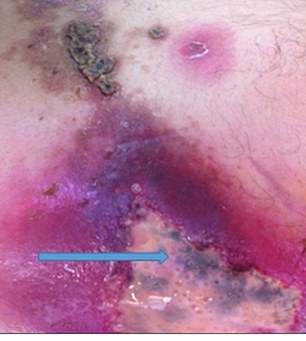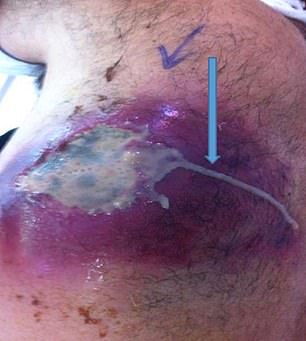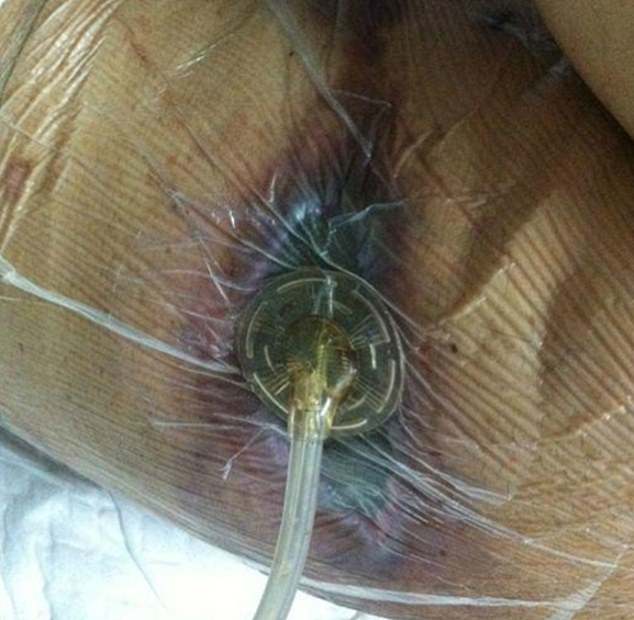A middle-aged man who was diagnosed with the virus that causes chickenpox and shingles has suffered a rare and potentially fatal infection that has eaten away at the flesh on his chest.
The 55-year-old man who was being treated for shingles went to the hospital with extreme swelling in his chest and a large open sore oozing a foul-smelling fluid, which doctors discovered was a rare complication of the herpes zoster virus, also known as shingles.
Flesh-eating infection, medically known as necrotizing fasciitis, is usually caused by bacterial infections.
Although rare, it can develop after infection with the virus that causes chickenpox and shingles. The severe rash results in open sores that welcome invading bacteria, which break down skin tissue.
Doctors used a vacuum-like device to drain the abscess after doctors removed layers of dead tissue.
The patient was being treated by doctors in Najran, Saudi Arabia, for shingles, a painful rash most often seen in older adults who had chickenpox as children.
Even after a person recovers from chickenpox, the shingles virus remains dormant in the body. It can reactivate with age and cause shingles.
The patient also had diabetes, which can weaken the immune system and impair its ability to keep the virus under control.
About one million Americans are diagnosed with shingles each year.
Shingles is preventable with a vaccine that protects nearly 100 percent of people from getting the infection. About 30 percent of older people who are eligible for the vaccine have received it.
The man developed the typical painful shingles rash around the front of his chest and upper abdomen.
The rash was treated with a topical cream and an antiviral medication normally used to treat the herpes family of viruses.
For about a week after starting the antiviral drugs, she suffered from chest pain and swelling near the rash, which did not respond to topical treatment. The pain persisted and she developed a high fever.
When she arrived at the emergency room, doctors said the swelling on the left side of her chest was “enormous” with pus discharge “and a foul odor associated with stabbing pain and fever.”
The sore on his chest was slightly larger than a standard-sized piece of printer paper.
Doctors gave him intravenous antibiotics and performed emergency surgery to drain the fluid and remove layers of dead tissue. In surgery, doctors discovered that the severe skin damage extended deeper into the man’s muscles.
Cultures of fluid taken from the man’s wound identified Staphylococcus aureus and Clostridium perfringens, strains that are resistant to certain antibiotics and therefore difficult to treat effectively.


A 55-year-old man presented to the hospital with a severe case of a flesh-eating bacterial infection that had caused a large sore on his torso.
For five days in the hospital, doctors cleaned and treated the wound for five days. Afterwards, a plastic surgeon closed the chest wound, using a vacuum for six days to help it heal, and then sutured it.
The patient was discharged in good condition after 16 days in the hospital, with the infection fully cured. His ordeal was detailed in the American Journal of Case Reports.
The shingles virus causes intense itching in a specific area, usually on one side of the body. This itching leads to a painful rash and fluid-filled blisters that break open and become sores.
Open sores are major entry points for bacteria to invade and cause secondary infections.
Treat a case of flesh-eating bacteria quickly with antibiotics and by removing layers of dead tissue.
Necrotizing fasciitis can spread quickly and destroy more and more tissue the longer it goes untreated. The CDC estimates that there are between 700 and 1,200 cases of necrotizing fasciitis in the U.S. each year.
To fight off an infection, the immune system sends immune cells to fight it, but this response can lead to widespread inflammation throughout the body, which can lead to decreased oxygen flow to vital organs.
Surgery to remove dead tissue is crucial; researchers say nearly 100 percent of patients die without it.


